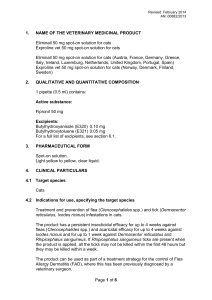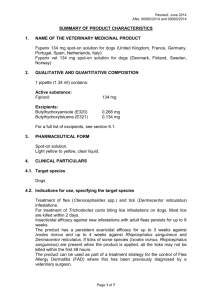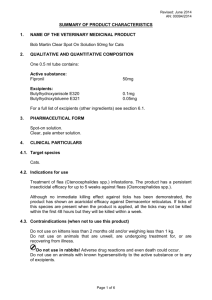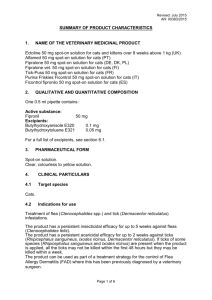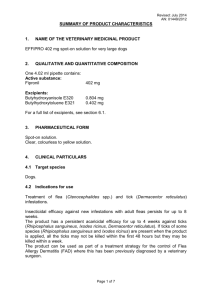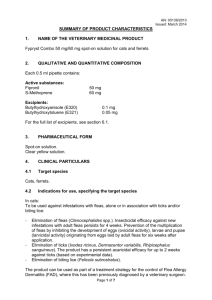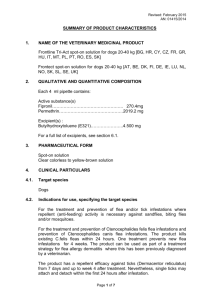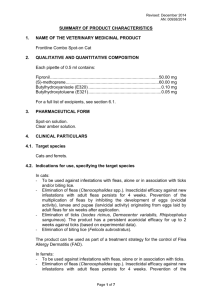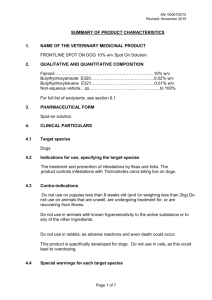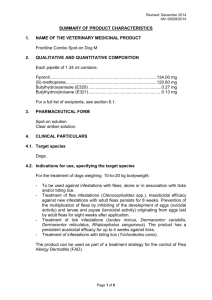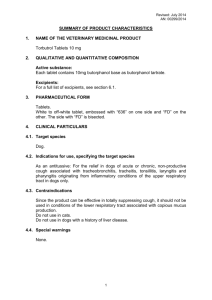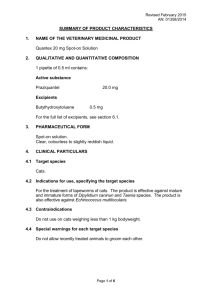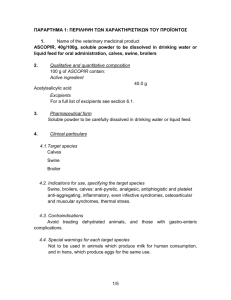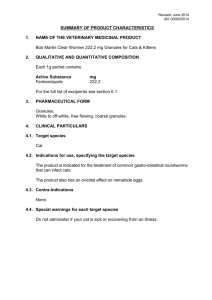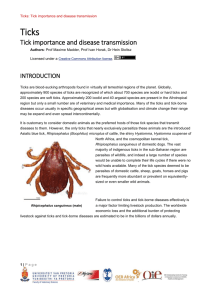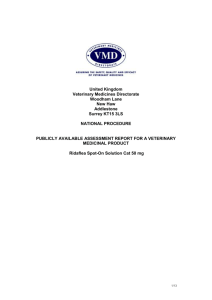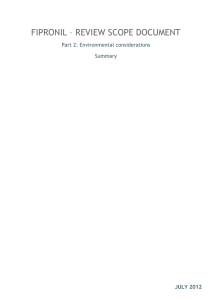Vm - Veterinary Medicines Directorate
advertisement
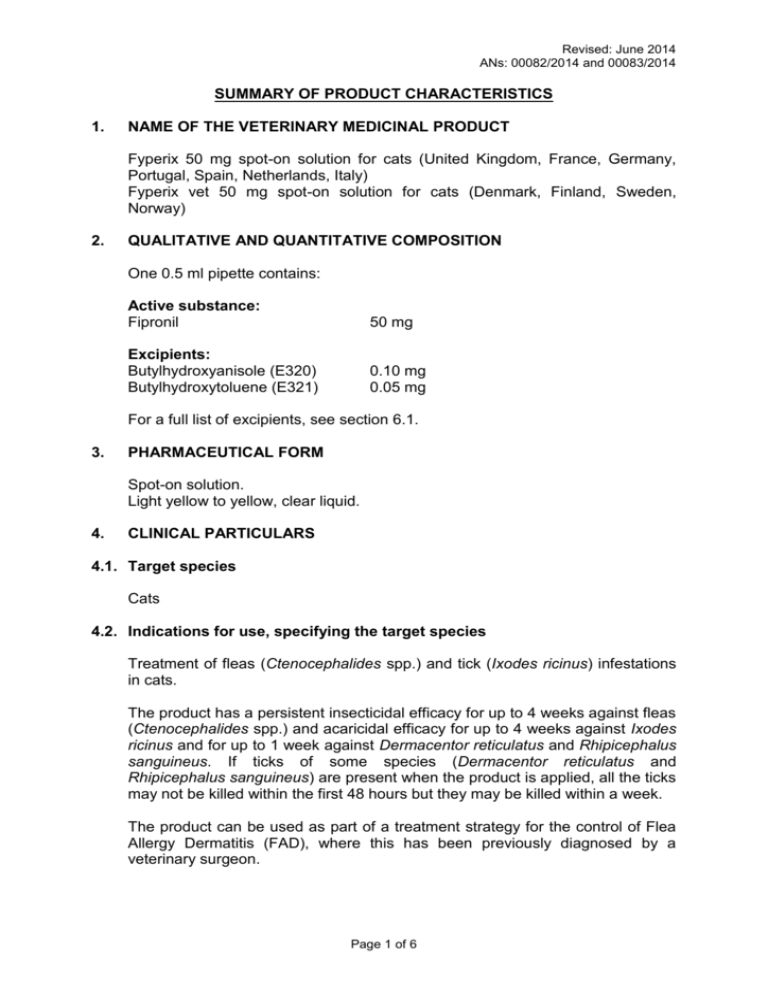
Revised: June 2014 ANs: 00082/2014 and 00083/2014 SUMMARY OF PRODUCT CHARACTERISTICS 1. NAME OF THE VETERINARY MEDICINAL PRODUCT Fyperix 50 mg spot-on solution for cats (United Kingdom, France, Germany, Portugal, Spain, Netherlands, Italy) Fyperix vet 50 mg spot-on solution for cats (Denmark, Finland, Sweden, Norway) 2. QUALITATIVE AND QUANTITATIVE COMPOSITION One 0.5 ml pipette contains: Active substance: Fipronil 50 mg Excipients: Butylhydroxyanisole (E320) Butylhydroxytoluene (E321) 0.10 mg 0.05 mg For a full list of excipients, see section 6.1. 3. PHARMACEUTICAL FORM Spot-on solution. Light yellow to yellow, clear liquid. 4. CLINICAL PARTICULARS 4.1. Target species Cats 4.2. Indications for use, specifying the target species Treatment of fleas (Ctenocephalides spp.) and tick (Ixodes ricinus) infestations in cats. The product has a persistent insecticidal efficacy for up to 4 weeks against fleas (Ctenocephalides spp.) and acaricidal efficacy for up to 4 weeks against Ixodes ricinus and for up to 1 week against Dermacentor reticulatus and Rhipicephalus sanguineus. If ticks of some species (Dermacentor reticulatus and Rhipicephalus sanguineus) are present when the product is applied, all the ticks may not be killed within the first 48 hours but they may be killed within a week. The product can be used as part of a treatment strategy for the control of Flea Allergy Dermatitis (FAD), where this has been previously diagnosed by a veterinary surgeon. Page 1 of 6 Revised: June 2014 ANs: 00082/2014 and 00083/2014 4.3. Contraindications In the absence of available data, the product should not be used on kittens less than 2 months old and/or weighing less than 1 kg. Do not use on sick (e.g. systemic diseases, fever…) or convalescent animals. Do not use in rabbits, as adverse reactions and even death could occur. Do not use in cases of hypersensitivity to the active substance, dimethyl sulfoxide or to any of other excipients. 4.4. Special warnings for each target species Fleas from pets often infest the animal's basket, bedding and regular resting areas such as carpets and soft furnishings which should be treated, in case of massive infestation and at the beginning of the control measures, with a suitable insecticide and vacuumed regularly. The product does not prevent ticks from attaching to the animals. If the animal has been treated prior to exposure to the ticks, the tick will be killed in the first 24-48 hours after attachment. This will usually be prior to engorgement, minimising but not excluding the risk of transmission of diseases. Once dead, ticks will often drop off the animal, but any remaining ticks may be removed with a gentle pull. No data on the effect of bathing/shampooing on the efficacy of the product in cats are available. However, based on information available for dogs, weekly immersion in water for one minute reduces the period of persistent insecticidal efficacy against fleas by one week. For optimum control of flea problems in a multi-pet household, all dogs and cats in the household should be treated with a suitable insecticide. When used as part of a strategy for the treatment of Flea Allergy Dermatitis, monthly applications to the allergic patient and to other cats in the household are recommended. Page 2 of 6 Revised: June 2014 ANs: 00082/2014 and 00083/2014 4.5. Special precautions for use i) Special precautions for use in animals Avoid contact with the animal's eyes. In the case of accidental eye contact, immediately and thoroughly flush the eyes with water. Do not apply the product on wounds or damaged skin. Animals should be weighed accurately prior to treatment. ii) Special precautions to be taken by the person administering the veterinary medicinal product to animals This product can cause mucous membrane and eye irritation. Therefore, contact between the product and the mouth or eyes should be avoided. In the case of accidental eye contact, immediately and thoroughly flush the eyes with water. If eye irritation persists seek medical advice and show the package leaflet or the label to the physician. Avoid contents coming into contact with the fingers. If this occurs, wash off immediately with soap and water. Wash hands after use. Do not smoke, drink or eat during application. People with a known hypersensitivity to fipronil or dimethyl sulfoxide or other excipients should avoid contact with the veterinary medicinal product. Treated animals should not be handled until the application site is dry, and children should not be allowed to play with treated animals until the application site is dry. It is therefore recommended that animals are not treated during the day, but should be treated during the early evening, and that recently treated animals should not be allowed to sleep with owners, especially children. 4.6. Adverse reactions (frequency and seriousness) If licking occurs, a brief period of hypersalivation may be observed. Among the extremely rare suspected adverse reactions, transient cutaneous reactions on the application site (squamosis, local alopecia, pruritus, erythema) and general pruritus or alopecia have been reported after use. Exceptionally, hypersalivation, reversible neurologic symptoms (hyperesthesia, depression, nervous symptoms) or vomiting have been observed after use. 4.7. Use during pregnancy, lactation or lay Laboratory studies using fipronil have not shown any evidence of teratogenic or embryotoxic effects. Studies have not been carried out with this product in pregnant and lactating queens. Use in pregnancy and lactation only in accordance with professional veterinary advice and a benefit/risk assessment. Page 3 of 6 Revised: June 2014 ANs: 00082/2014 and 00083/2014 4.8. Interaction with other medicinal products and other forms of interaction None known. 4.9. Amounts to be administered and administration route Route of administration and dosage: External use only. Administer by topical application to the skin 1 pipette of 0.5 ml per animal.. Method of administration: Remove the pipette from the triplex bag. Hold the pipette in an upright position, twist and pull the cap off. Turn the cap around and place the other end of the cap back on the pipette. Push and twist the cap to break the seal, then remove the cap from the pipette. Spread the hairs of the animal between the shoulder blades to make the skin visible. Place the tip of the pipette on the skin and squeeze gently to empty its contents onto the skin, preferably at two spots, one at the base of the skull and a second 2-3 cms further back. It is important to make sure that the product is applied to an area where the animal cannot lick it off, and to make sure that animals do not lick each other following treatment. The hair should be parted and the product applied to the skin. Temporary changes to the coat (clumped/greasy hair and/or deposits on the hair) may be noted at the application site which normally disappears within 24 hours. Treatment schedule: For optimal control of flea and/or tick infestation the treatment schedule can be based on the local epidemiological situation. In the absence of safety studies, the minimum treatment interval is 4 weeks. 4.10. Overdose (symptoms, emergency procedures, antidotes), if necessary No adverse effects were observed in target animal safety studies in cats and kittens aged 2 months and older and weighing about 1 kg treated once a month at five times the recommended dose for three consecutive months. The risk of experiencing adverse effects may however increase with overdosing. 4.11. Withdrawal period Not applicable. Page 4 of 6 Revised: June 2014 ANs: 00082/2014 and 00083/2014 5. PHARMACOLOGICAL PROPERTIES Pharmacotherapeutic group: Ectoparasiticides for topical use. ATCVet Code: QP53AX15 5.1. Pharmacodynamic properties Fipronil is an insecticide and acaricide belonging to the phenylpyrazole family. It acts by inhibiting the GABA complex, binding to the chloride channel and thereby blocking pre-and post-synaptic transfer of chloride ions across cell membranes. This results in uncontrolled activity of the central nervous system and death of insects or acarids. Fipronil exhibits an insecticidal and acaricidal activity against fleas (Ctenocephalides spp.) and ticks (Rhipicephalus spp., Dermacentor spp., Ixodes spp. including Ixodes ricinus) in the cat. Fleas will be killed within 24 hours. Ticks will usually be killed within 48 h after contact with fipronil, however if ticks of some species (Dermacentor reticulatus and Rhipicephalus sanguineus ) are present when the product is applied, all of the ticks may not be killed within the first 48 hours, but may be killed within a week. 5.2. Pharmacokinetic properties In vitro, fipronil is mainly metabolised with subcellular liver fractions to its sulfone derivative. However, this may be of limited relevance “in vivo” as fipronil is poorly absorbed in the cat. The concentrations of fipronil on the hair decrease with time. 6. PHARMACEUTICAL PARTICULARS 6.1. List of excipients Butylhydroxyanisole (E320) Butylhydroxytoluene (E321) Polysorbate 80 Povidone K25 Dimethyl sulfoxide 6.2. Incompatibilities None known. 6.3. Shelf life Shelf-life of the veterinary medicinal product as packaged for sale: 30 months. Page 5 of 6 Revised: June 2014 ANs: 00082/2014 and 00083/2014 6.4. Special precautions for storage Store in the original container in order to protect from light and moisture. The product should be maintained at room temperature (above 14°C) for approximately one hour prior to administration. 6.5. Nature and composition of immediate packaging White polypropylene pipette closed with either a polyethylene or polyoxymethylene cap. Each 0.5 ml pipette is packed in a polyethylene terephthalate/aluminium/low density polyethylene triplex bag. Box containing 1, 3, 6, 10, 20 or 30 pipettes. Not all pack sizes may be marketed. 6.6. Special precautions for the disposal of unused veterinary medicinal product or waste materials derived from the use of such products Any unused veterinary medicinal product or waste materials derived from such veterinary medicinal products should be disposed of in accordance with local requirements. Fipronil may adversely affect aquatic organisms. Do not contaminate ponds, waterways or ditches with the product or empty container. 7. MARKETING AUTHORISATION HOLDER KRKA, d.d., Novo mesto Šmarješka cesta 6 8501 Novo mesto Slovenia 8. MARKETING AUTHORISATION NUMBER Vm: 01656/4036 9. DATE OF FIRST AUTHORISATION Date: 20 September 2012 10. DATE OF REVISION OF THE TEXT Date: June 2014 24 July 2014 Page 6 of 6
